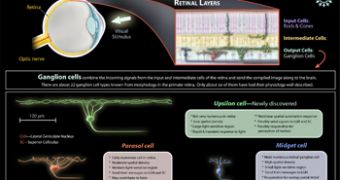90 % of the information we get about our environment comes through our eyes. Humans are visual beings. But how light turns into visual sensations is hard to explain. A new research published in Neuroscience sheds light on how the human and primate retinas turn light into signals going to the brain.
The team funded by the National Science Foundation (NSF) discovered a cell type in the output (ganglion cell) layer of the retina that could be the main actor in turning visual images captured by the rods and cones into nerve signals going to the brain. Increased knowledge on the process could lead to the development of devices designed to induce artificial sight to the blind.
This retinal cell type was first detected in the '60s in other animals, and now it was discovered in primates. "To find these cells after so many decades of searching is truly a stunning achievement. The discovery was made by a multidisciplinary team of physicists and neuroscientists working together on the problem. These results highlight the importance of supporting a cross approach when investigating complex biological processes.", said NSF Program Director Krastan Blagoev.
The research has been a "fantastic journey through high-energy physics, neurobiology, technology and human health.", said lead researcher Alan Litke, adjunct professor of physics at the University of California at Santa Cruz.
Litke's team applied technology employed for investigating fundamental particles like top quark and Higgs boson to retina and neural systems. "Now we are using the new technology for experiments that will help guide the design of future retinal prosthetic devices.", said Litke.
The team discovered over 22 various types of retinal ganglion cells in the primate retina. The physiological behavior of these ganglion cells is crucial in understanding how a primate's retina works. By now, only several of these cells have been investigated in detail.
The novel 512-multielectrode array system for large-scale recording of neural activity enabled the team to find a physiologically distinct type of ganglion cells, dubbed "upsilon cells", which could be involved in the motion perception. "The upsilon cells went undetected by traditional physiological techniques for so long because they are a tiny fraction of the million ganglion cells in the primate retina.", said Litke.

 14 DAY TRIAL //
14 DAY TRIAL //